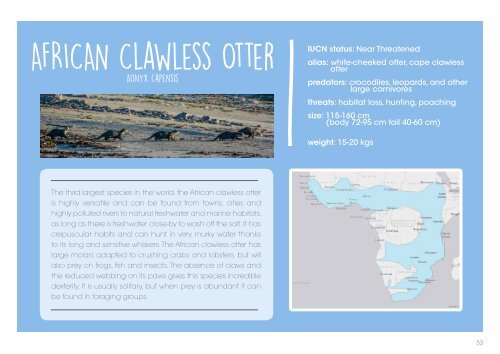OTTERS!
joopj4x
joopj4x
You also want an ePaper? Increase the reach of your titles
YUMPU automatically turns print PDFs into web optimized ePapers that Google loves.
AFRICAN Clawless Otter<br />
Aonyx capensis<br />
IUCN status: Near Threatened<br />
alias: white-cheeked otter, cape clawless<br />
otter<br />
predators: crocodiles, leopards, and other<br />
large carnivores<br />
threats: habitat loss, hunting, poaching<br />
size: 115-160 cm<br />
(body 72-95 cm tail 40-60 cm)<br />
weight: 15-20 kgs<br />
The third largest species in the world, the African clawless otter<br />
is highly versatile and can be found from towns, cities and<br />
highly polluted rivers to natural freshwater and marine habitats,<br />
as long as there is freshwater close-by to wash off the salt. It has<br />
crepuscular habits and can hunt in very murky water thanks<br />
to its long and sensitive whiskers. The African clawless otter has<br />
large molars adapted to crushing crabs and lobsters, but will<br />
also prey on frogs, fish and insects. The absence of claws and<br />
the reduced webbing on its paws gives this species incredible<br />
dexterity. It is usually solitary, but when prey is abundant it can<br />
be found in foraging groups.<br />
53


